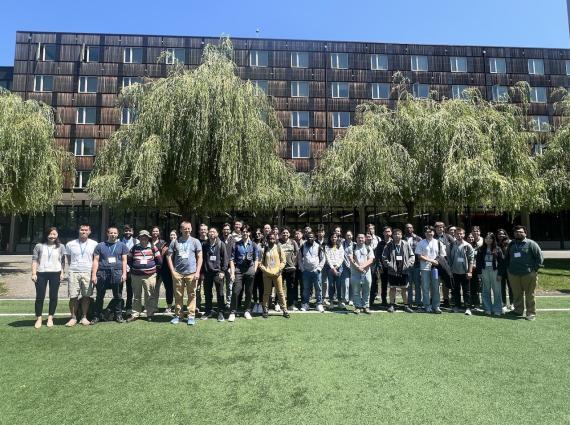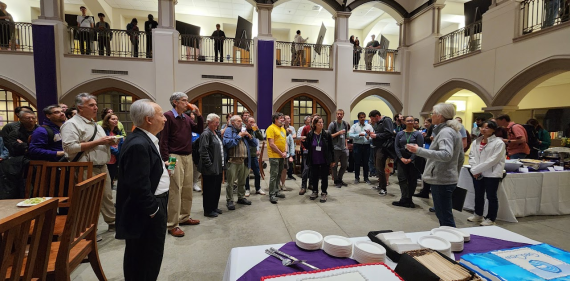The Second Conference on Random Matrix Theory and Numerical Linear Algebra
Scientists and mathematicians met at the University of Washington during the week of June 16, 2025 for the Second Conference on Random Matrix Theory and Numerical Linear Algebra (RMT + NLA II). The event (co-organized by Tom Trogdon and Xuicai Ding (UC Davis)) brought together experts studying random matrix theory and exploring how it can help solve fundamental problems in numerical linear algebra, artificial intelligence and quantum mechanics.
In addition to 20+ focused research talks, the conference featured three main lecture series, each addressing different challenges. Giorgio Cipolloni taught participants about using Wigner matrices to study quantum chaos, the unpredictable behavior of quantum systems at the atomic level. While quantum chaos remains mathematically intractable in most real physical systems, these probabilistic models offer a more manageable framework for understanding core principles like Quantum Unique Ergodicity and the Eigenstate Thermalization Hypothesis. Cipolloni demonstrated how recently developed multi-resolvent local laws enable researchers to construct deterministic approximations of these complex quantum phenomena.
Govind Menon's lectures examined deep linear networks, which serve as simplified models of how neural networks learn. Despite their apparent simplicity, these models reveal subtle mathematical structures that illuminate the training dynamics of deep learning systems. Menon explained the underlying Riemannian geometry of these networks, drawing connections to interior point methods used in optimization theory and clarifying why certain training approaches prove more effective than others.
Michael W. Mahoney discussed how contemporary machine learning is pushing random matrix theory into new theoretical territory. Today's AI systems are so large and overparameterized that traditional analytical tools often prove inadequate. Mahoney presented novel approaches for characterizing neural network performance without access to training data, accelerating computations through sparse embeddings and "algorithmic gaussianization," and analyzing heavy-tailed spectral structures that appear ubiquitously in modern diagnostics. He also introduced techniques for studying "impalpable matrices"—systems so massive they cannot be explicitly formed or even fully queried through matrix-vector products.
The conference underscored how random matrix theory has evolved from an elegant mathematical discipline into an essential framework for understanding and implementing large-scale computations.
Structure-Preserving Scientific Computing and Machine Learning Summer School and Hackathon

From June 16 to 25, 2025, we hosted the “Structure-Preserving Scientific Computing and Machine Learning Summer School and Hackathon” at the University of Washington, Seattle (https://sites.google.com/view/crg-spd/events/seattle-2025).
The event was a great success—we welcomed 36 graduate students from 21 different institutions across the United States and Canada (not including local participants). It began with a one-week summer school, taught by three leading experts in their respective fields, followed by a three-day hackathon led by four projects leaders representing academia, government agencies, industry, and national laboratories.
This event was co-sponsored by the PIMS CRG grant and the Computational Mathematics and Applied Mathematics Programs at the National Science Foundation.
5th Biennial Meeting of the SIAM Pacific Northwest Chapter

The SIAM Pacific Northwest Chapter kicked off the start of autumn quarter by holding the chapter’s 5th biennial meeting in Seattle, Washington over October 3-5th. In addition to holding a lively conference with the largest attendance recorded in the history of our meetings, this meeting coincided with a celebration of UW Emeritus Professor Randy Leveque’s 70th birthday.
This gave us the opportunity to celebrate Randy’s long career of instrumental contributions to the field of numerical analysis, as well as his impact and influence in the creation of a strong and vibrant community of applied mathematicians in the Pacific Northwest. Highlights of the conference included plenary speakers Vrushali Bokil (OSU), David Ketcheson (KAUST), and Keh-Ming Shyue (NTU). The conference dinner included CLAWPACK and GEOCLAW-themed birthday cakes and an impressive poster supplying a complete geonological history of Randy’s mathematical lineage.
It was held in concert with a poster presentation session showcasing the impressive work of many graduate students and early-career scholars working in the Pacific Northwest region. 1st place prizes were awarded to Eleanor Courcelle (OSU) for her poster titled “Coming Full Circle: Persistence of n-Species Lotka-Volterra Models with Pulsed Perturbations” and Mateus Piovezan Otto (UW) for his poster titled “Stochastic Jacobi-type Algorithms for Independent Component Analysis”. A second place prize was awarded to Eric Gelphman (Colorado School of Mines) for his poster titled “Finite Volume Spectral Domian (FVSD) Method for Solving Parabolic PDEs” and a third place prize was awarded to Olayemi Adeyemi (BSU) for her poster titled “High-Order Galerkin vs. Traditional Methods: A Multi-Resolution Atmospheric Modeling Study”. The SIAM PNW section officers (Donna Calhoun—President, Brittany Erickson—Vice President, Weiran Sun—Secretary, and Heather Wilber—Treasurer) wish to thank all participants, as well as the large group of UW graduate student volunteers that helped make this conference a spectacular success! We are also grateful to multiple sponsors, including SIAM, the NSF, PIMS, and the UW Applied Mathematics Department. We look forward to the next biennial meeting in 2027!